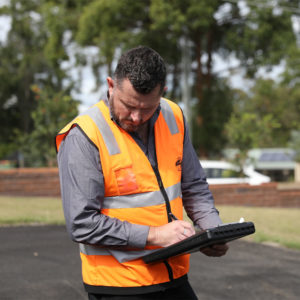Like everything, asphalt needs proper maintenance. While it is more flexible and cost effective than concrete even in the long term, there are some basics to be considered when it comes to caring for your asphalt surfaces.
1. Avoid excessive loads where possible
Like vehicles, the road pavement has a load carrying capacity. And like house foundations, the road base supports the asphalt or bitumen surface. A car park or domestic driveway will usually have 100mm of road base and 25mm of asphalt overlay, as a minimum. This surface is extremely durable, weather resistant and more than adequately carries the load of a car or small truck (up to 3 tonne). However, large or heavy vehicles with excessive loads can cause cracks or deform the asphalt surface allowing water to enter the road base, creating larger cracks and potholes.
Solution: watch for cracks, breaks or potholes and treat them early to keep the asphalt surface in tip top condition.
2. Ensure adequate drainage
If the sub-base drainage is inadequate, rainwater can enter the road base and the area below the road base (sub-base), causing the sub-base to soften. Unlike concrete, asphalt has some amount of tolerance but, if left untreated, eventually traffic moving over the area will cause deformation and cracking in the bitumen or asphalt surface. This is what causes the majority of potholes.
Solution: again, watch for cracks, breaks or potholes and treat them early. Check your surfaces particularly after heavy rain or prolonged wet weather, or environmental changes that may cause the sub-base to degrade.
3. Mop up chemical spills quickly
Asphalt and bitumen are a natural by-product of oil refining and make the most of our natural resources. However, when petrol, oil and some chemicals are spilt onto asphalt, the contacted area can soften making it susceptible to damage even from light traffic.
Solution: Tend to oil and chemical spills quickly using effective cleaning processes.
4. Consider wear, tear and age
Even a hard-working surface like asphalt has a limited life span and, like most things deterioration with age is inevitable. Asphalt can withstand most things our weather and general use can throw at it, but exposure to air eventually causes oxidation resulting in binders breaking down and weakening. Traffic will inevitably accelerate the decomposition, allowing water to enter the road base causing the pavement to sink… creating potholes.
Solution: Rejuvenate old asphalt surfaces as required to protect the road base and prevent erosion.
5. Clay bases become bog when wet
South East Queensland has many areas where the sub-grade (ground) is clay based. In fact, most of Brisbane sits on a clay base. When it’s dry and hard, most likely clay won’t cause any problems. However, heavy and prolonged rain causes wet clay to become pliable and subject to movement. This can result in bitumen or asphalt cracks, potholes that appear from nowhere, and your asphalt looking more like a corrugated country road than a smooth, durable and safe surface.
Solution: Monitor surfaces for cracks and hazards, particularly after rain. Tend to small problems before they become major headaches.
6. Get the job done right the first time!
Far too regularly we are called on to repair an asphalt area that has been constructed recently, usually by some operator that is only in the business to make a quick buck. If you don’t know what your contractor should be doing, or if you’re not around when the job gets done you can easily get scammed.
Minimum engineering standards are required for an asphalt pavement to last. PHP Asphalt and Construction (Pothole People Qld) has an enviable and professional reputation which we value and uphold, and we guarantee all of our work. We are a member of the Australian Asphalt Pavement Association (AAPA) and the Civil Contractors Federation (CCF).
Solution: Get it done right the first time! Call or email us now.



